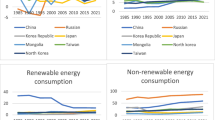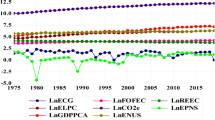Abstract
The transition of most economies especially heavily industrialized nations like China, Turkey, Russia, India, Indonesia, Brazil, and Mexico fondly known as E7 are fast emerging economies with its impact on economic growth and ecosystem. On the above highlight, the present study explores the dynamic interaction between hydroelectricity energy, renewable energy consumption, nonrenewable energy consumption on economic growth over annual time frequency data from 1990 to 2018. To this end, Kao co-integration technique is adopted in conjunction with panel ordinary least squares, dynamic ordinary least squares, and fully modified ordinary least square estimators over the identified blocs while the heterogeneous causality test of Dumitrescu and Hurlin is employed to detect the direction of causality among the variables. Empirical result shows long-run analysis reveals long-run equilibrium relationship between the examined variables. Furthermore, a one-way causality relationship is observed between economic growth and nonrenewable energy, economic growth and renewable energy, and economic growth and pollutant emission. The present study identifies a U-shaped pattern among nonrenewable energy consumption and economic growth in the long-run. These findings suggest that as economic growth increases, there is less strengthening of energy from the nonrenewable energy consumption hence, portentous deterioration in nonrenewable usage while authenticating the proficiency of nonrenewable energy consumption in the E7 countries. Further policy prescriptions are rendered in the concluding section.
Similar content being viewed by others
Notes
For brevity, more descriptions are presented in Appendix 1 and basic summary statistics into the data are in appendix 2.
References
Acaravci A, Ozturk I (2010) On the relationship between energy consumption, CO2 emissions and economic growth in Europe. Energy 35:5412–5420
Adedoyin FF, Gumede MI, Bekun FV, Etokakpan MU, Balsalobre-lorente D (2020a) Modelling coal rent, economic growth and CO2 emissions: does regulatory quality matter in BRICS economies? Sci Total Environ 710:136284
Adedoyin FF, Alola AA, Bekun FV (2020b) An assessment of environmental sustainability corridor: the role of economic expansion and research and development in EU countries. Sci Total Environ 136726
Apergis N, Ozturk I (2015) Testing environmental Kuznets curve hypothesis in Asian countries. Ecol Indic 52:16–22
Apergis N, Payne JE (2010a) Renewable energy consumption and growth in Eurasia. Energy Econ 32:1392–1397
Apergis N, Payne JE (2010b) Renewable energy consumption and economic growth: evidence from a panel of OECD countries. Energy Policy 38(1):656–660
Apergis N, Payne JE (2012) Renewable and non-renewable energy consumption growth nexus: evidence from a panel error correction model. Energy Econ 34(3):733–738
Apergis N, Payne JE (2014) Renewable energy, output, CO2 emissions, and fossil fuel prices in Central America: evidence from a nonlinear panel smooth transition vector error correction model. Energy Econ 42:226–232
Asongu S, El Montasser G, Toumi H (2016) Testing the relationships between energy consumption, CO 2 emissions, and economic growth in 24 African countries: a panel ARDL approach. Environ Sci Pollut Res 23(7):6563–6573
Asongu SA, Le Roux S, Biekpe N (2017) Environmental degradation, ICT and inclusive development in Sub-Saharan Africa. Energy Policy 111:353–361
Balcilar M, Ozdemir ZA, Arslanturk Y (2010) Economic growth and energy consumption causal nexus viewed through a bootstrap rolling window. Energy Econ 32(6):1398–1410
Baranzini A, Weber S, Bareit M, Mathys NA (2013) The causal relationship between energy use and economic growthin Switzerland. Energy Economics 36:464–470
Bekun FV, Emir F, Sarkodie SA (2019a) Another look at the relationship between energy consumption, carbon dioxide and economic growth in South Africa. Sci Total Environ 655(2019):759–765
Bekun FV, Alola AA, Sarkodie SA (2019b) Toward a sustainable environment: Nexus between CO2 emissions, resource rent, renewable and nonrenewable energy in 16-EU countries. Sci Total Environ 657:1023–1029
Ben Jebli M, Ben YS (2015) The environmental Kuznets curve, economic growth, renewable and non-renewable energy, and trade in Tunisia. Renew Sust Energ Rev 47:173–185
Bento JPC, Moutinho V (2016) CO2 emissions, non-renewable and renewable electricity production, economic growth, and international trade in Italy. Renew Sust Energ Rev 55:142–155
Cho CH, Chu YP, Yang HY (2013) An environment Kuznets curve for GHG emissions: a panel cointegration analysis. Energy Sources Part B: Econ Plan Policy 9:120–129
Cole MA (2004) Trade, the pollution haven hypothesis and the environmental Kuznets curve: examining the linkages. Ecol Econ 48:71–81
Damette O, Seghir M (2013) Energy as a driver of growth in oil exporting countries? Energy Econ 37:193–199
Danish, Wang Z (2019) Does biomass energy consumption help to control environmental pollution? Evidence from BRICS countries. Sci Total Environ 670:1075–1083. https://doi.org/10.1016/j.scitotenv.2019.03.268
Danish, Zhang B, Wang B, Wang Z, Zhang B, Wang B, Wang Z (2017) Role of renewable energy and non-renewable energy consumption on EKC: evidence from Pakistan. J Clean Prod 156:855–864. https://doi.org/10.1016/j.jclepro.2017.03.203
Danish BMA, Mahmood N, Zhang JW (2019) Effect of natural resources, renewable energy and economic development on CO 2 emissions in BRICS countries. Sci Total Environ 678:632–638. https://doi.org/10.1016/j.scitotenv.2019.05.028
Department of Minerals and Energy (2016) Digest of South African energy statistics. Republic of South Africa
Dumitrescu E-I, Hurlin C (2012) Testing for granger non-causality in heterogeneous panels. Econ Model 29:1450–1460
EC (2009) Renewable Energy Directive (2009/28/EC). European Commission, Brussels
EC. 2010. Energy (2020) A strategy for competitive, sustainable and secure energy COM/2010/0639 final. Brussels: European Commission
Emir F, Bekun FV (2019) Energy intensity, carbon emissions, renewable energy, and economic growth nexus: new insights from Romania. Energy Environ 30(3):427–443
Galeotti M, Lanza A, Pauli F (2006) Reassessing the environmental Kuznets curve for CO2 emissions: a robustness exercise. Ecol Econ 57:152–163
Ghali KH, El-Sakka MI (2004) Energy use and output growth in Canada: a multivariate cointegration analysis. Energy Econ 26(2):225–238
Halicioglu F (2009) An econometric study of CO 2 emissions, energy consumption, income and foreign trade in Turkey. Energy Policy 37(3):1156–1164
Inglesi-Lotz R, Pouris A (2016) On the causality and determinants of energy and electricity demand in South Africa: a review. Energy Sources Part B 11:626–636
IPCC, 2016. IPCC Report Graphics. Retrieved from. https://www.ipcc.ch/report/graphics/index.php?t=Assessment%20Reports&r=AR5%20-%20Synthesis%20Report&f=SPM.
Jamil F, Eatzaz A (2010) The relationship between electricity consumption, electricity prices and GDP in Pakistan. Energy Policy 38:6016–6025
Kao C (1999) Spurious regression and residual – based tests for cointegration in panel data. J Econ 90:1–44. https://doi.org/10.1016/S0304-4076(98)00023-2
Lee CC, Chang CP, Chen PF (2008) Energy-income causality in OECD countries revisited: the key role of capital stock. Energy Econ 30:2359–2373
Menyah K, Wolde-Rufael Y (2010) Energy consumption, pollutant emissions and economic growth in South Africa. Energy Econ 32(6):1374–1382
Owusu P, Asumadu SS (2016) A review of renewable energy sources, sustainability issues and climate change mitigation. Cogent Eng. 3, 1,167,990. https://doi.org/10.1080/23311916.2016.1167990
Pedroni P (2001) Purchasing power parity tests in cointegrated panels. Rev Econ Stat 83:727–731. https://doi.org/10.1162/003465301753237803
Pedroni P (2004) Panel cointegration: asymptotic and finite sample properties of pooled time series tests with an application to the PPP hypothesis. Econ Theory 20:597–625. https://doi.org/10.1017/S0266466604203073
Sarkodie SA, Adom PK (2018) Determinants of energy consumption in Kenya: a NIPALS approach. Energy 159:696–705. https://doi.org/10.1016/j.energy.2018.06.195
Sarkodie SA, Crentsil AO, Owusu PA (2019) Does energy consumption follow asymmetric behavior? An assessment of Ghana’s energy sector dynamics. Sci Total Environ 651:2886–2898. https://doi.org/10.1016/j.scitotenv.2018.10.147
Sebri M, Ben-Salha O (2014) On the causal dynamics between economic growth, renewable energy consumption, CO2 emissions and trade openness: fresh evidence from BRICS countries. Renew Sust Energ Rev 39:14–23
Soytas U, Sari R (2006) Energy consumption and income in G-7 countries. J Policy Model 28(7):739–750
Soytas U, Sari R (2009) Energy consumption, economic growth, and carbon emissions: challenges faced by an EU candidate member. Ecol Econ 68:1667–1675. https://doi.org/10.1016/j.ecolecon.2007.06.014
Tang CF, Tan EC (2013) Exploring the nexus of electricity consumption, economic growth, energy prices and technology innovation in Malaysia. Appl Energy 104:297–305
UN (1998) Kyoto protocol to the United Nations framework convention on climate change. United Nations, New-York
UN (2012) Doha amendment to Kyoto protocol. In: New-York. Nations, United
Wang Z, Danish, Zhang B, Wang B (2018) Renewable energy consumption, economic growth and human development index in Pakistan: evidence form simultaneous equation model. J Clean Prod 184:1081–1090. https://doi.org/10.1016/j.jclepro.2018.02.260
Winkler H. 2007. Long term mitigation scenarios: technical report.
World Bank. (2019). Development indicators. http://databank.worldbank.org, (Accessed date: December, 2019).
Author information
Authors and Affiliations
Corresponding author
Additional information
Responsible editor: Nicholas Apergis
Publisher’s note
Springer Nature remains neutral with regard to jurisdictional claims in published maps and institutional affiliations.
Appendices
Appendix 1. Explanation of statistical data
Variable | Explanation | Sources |
|---|---|---|
Renewable energy consumption (% of total final energy consumption) | Renewable energy consumption is the share of renewable energy in total final energy consumption. | World Bank, Sustainable Energy for All (SE4ALL) database from the SE4ALL Global Tracking Framework led jointly by the World Bank, International Energy Agency, and the Energy Sector Management Assistance Program. |
CO2 emissions (kt) | Carbon dioxide emissions are those stemming from the burning of fossil fuels and the manufacture of cement. They include carbon dioxide produced during consumption of solid, liquid, and gas fuels and gas flaring. | Carbon Dioxide Information Analysis Center, Environmental Sciences Division, Oak Ridge National Laboratory, Tennessee, United States. |
Population, total | Total population is based on the de facto definition of population, which counts all residents regardless of legal status or citizenship. The values shown are midyear estimates. | (1) United Nations Population Division. World Population Prospects: 2019 Revision. (2) Census reports and other statistical publications from national statistical offices, (3) Eurostat: Demographic Statistics, (4) United Nations Statistical Division. Population and Vital Statistics Report (various years), (5) U.S. Census Bureau: International Database, and (6) Secretariat of the Pacific Community: Statistics and Demography Programmer. |
Trade (% of GDP) | Trade is the sum of exports and imports of goods and services measured as a share of gross domestic product. | World Bank national accounts data, and OECD National Accounts data files. |
GDP per capita (constant 2010 US$) | GDP per capita is gross domestic product divided by midyear population. GDP is the sum of gross value added by all resident producers in the economy plus any product taxes and minus any subsidies not included in the value of the products. It is calculated without making deductions for depreciation of fabricated assets or for depletion and degradation of natural resources. Data are in constant 2010 U.S. dollars. | World Bank national accounts data, and OECD National Accounts data files. |
Electricity production from hydroelectric sources (% of total) | Sources of electricity refer to the inputs used to generate electricity. Hydropower refers to electricity produced by hydroelectric power plants. | IEA Statistics © OECD/IEA 2014 (http://www.iea.org/stats/index.asp), subject to https://www.iea.org/t&c/termsandconditions/ |
Fossil fuel energy consumption (% of total) | Fossil fuel comprises coal, oil, petroleum, and natural gas products. | IEA Statistics © OECD/IEA 2014 (http://www.iea.org/stats/index.asp), subject to https://www.iea.org/t&c/termsandconditions/ |
Appendix 2. Corrections matrix

Rights and permissions
About this article
Cite this article
Gyamfi, B.A., Bein, M.A. & Bekun, F.V. Investigating the nexus between hydroelectricity energy, renewable energy, nonrenewable energy consumption on output: evidence from E7 countries. Environ Sci Pollut Res 27, 25327–25339 (2020). https://doi.org/10.1007/s11356-020-08909-8
Received:
Accepted:
Published:
Issue Date:
DOI: https://doi.org/10.1007/s11356-020-08909-8




